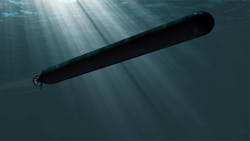Lockheed Martin to capitalize on XLUUV work for enabling technologies in future unmanned undersea vehicles
WASHINGTON U.S. – Navy undersea warfare experts are trying to capitalize on previous investments to develop navigation autonomy, and payload-deployment technologies for future generations of unmanned underwater vehicles (UUVs).
Officials of the Naval Sea Systems Command in Washington announced a $9.6 million order Wednesday to the Lockheed Martin Corp. Rotary and Mission Systems segment in Riviera Beach, Fla., to enhance UUV subsystems that the company developed previously under the Extra Large Unmanned Undersea Vehicle (XLUUV) program.
Lockheed Martin and the Boeing Defense, Space & Security segment in Huntington Beach, Calif., won contracts from Naval Sea Systems Command in September 2017 to design the Orca XLUUV. Those contracts -- $43.2 million for Lockheed Martin and $42.3 million for Boeing -- were to build prototype Orca XLUUV systems.
The Navy chose Boeing to move forward with the XLUUV program last February with a $43 million order to build four Orca large UUVs. Now Navy officials want Lockheed Martin to continue developing enabling technologies for future UUV systems for undersea navigation, machine autonomy, and payload deployment, based on the company's XLUUV work.
The modular-construction Orca XLUUV will be an open-architecture reconfigurable UUV with the core vehicle providing guidance and control, navigation, autonomy, situational awareness, core communications, power distribution, energy and power, propulsion and maneuvering, and mission sensors, Navy officials say.
The Orca XLUUV will have well-defined interfaces for cost-effective future upgrades to capitalize on advances in technology and respond to threat changes. The Orca XLUUV will have a modular payload bay, with defined interfaces to support current and future UUV payloads.
XLUUVs, which are among the largest unmanned submersibles ever conceived, will be for long-endurance surveillance missions or undersea cargo vessels to deliver other sensor payloads and other UUVs.
These large unmanned undersea vehicles eventually could be used as motherships to deploy and recover smaller surveillance UUVs on far-flung reconnaissance, surveillance, or special warfare missions in the open ocean or along coastlines and inside harbors.
The Navy and the U.S. Defense Advanced Research Projects Agency (DARPA) in Arlington, Va., have involved Lockheed Martin and Boeing on a variety of large UUV projects such as the Large-Displacement Unmanned Underwater Vehicle (LDUUV) project.
An LDUUV typically is described as an autonomous submarine no larger than 80 inches in diameter. Future XLUUVs likely will be larger. Experience with the LDUUV will help inform concepts for using XLUUV.
The Orca project also is developing a delivery system for payloads that could involve persistent-surveillance sensors, weapons, or other unmanned underwater vehicles (UUVs) and unmanned aerial vehicles (UAVs).
The Navy's XLUUV project is moving enabling technologies forward that were developed originally in other projects such as the DARPA Hydra program to develop an unmanned submersible large enough to transport and deploy UAVs and UUVs stealthily in enemy territory to respond quickly to situations around the world.
Boeing and Lockheed Martin both were involved in a DARPA project in 2015 ago called Blue Wolf, which focused on revolutionary underwater propulsion and drag-reduction technologies to enable manned and unmanned military undersea vehicles to move through the water faster and more energy-efficiently than ever before.
The Blue Wolf program demonstrated integrated underwater vehicle prototypes able to operate at speed and range combinations previously unachievable in fixed-size platforms, while retaining traditional volume and weight fractions for payloads and electronics.
Lockheed Martin also has been involved in a U.S. Special Operations Command (SOCOM) Dry Combat Submersible (DCS) program to design an affordable mini-submarine able to transport Special Operations combat swimmers such as Navy SEALs covertly while minimizing swim time to keep the divers from becoming too exhausted to carry out their missions.
Lockheed Martin also has experience with the Navy's Remote Multi-Mission Vehicles (RMMV) UUVs for use in countermine warfare aboard the U.S. Navy's Littoral Combat Ship.
On this order Lockheed Martin will do the work in Work will be performed in Riviera Beach, Fla., and should be finished by June 2020. For more information contact Lockheed Martin Rotary and Mission Systems online at www.lockheedmartin.com.
About the Author
John Keller
Editor-in-Chief
John Keller is the Editor-in-Chief, Military & Aerospace Electronics Magazine--provides extensive coverage and analysis of enabling electronics and optoelectronic technologies in military, space and commercial aviation applications. John has been a member of the Military & Aerospace Electronics staff since 1989 and chief editor since 1995.
